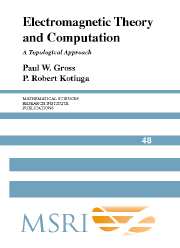Book contents
- Frontmatter
- Contents
- Preface
- Introduction
- Chapter 1 From Vector Calculus to Algebraic Topology
- Chapter 2 Quasistatic Electromagnetic Fields
- Chapter 3 Duality Theorems for Manifolds With Boundary
- Chapter 4 The Finite Element Method and Data Structures
- Chapter 5 Computing Eddy Currents on Thin Conductors with Scalar Potentials
- Chapter 6 An Algorithm to Make Cuts for Magnetic Scalar Potentials
- Chapter 7 A Paradigm Problem
- Mathematical Appendix: Manifolds, Differential Forms, Cohomology, Riemannian Structures
- Bibliography
- Summary of Notation
- Examples and Tables
- Index
Chapter 4 - The Finite Element Method and Data Structures
Published online by Cambridge University Press: 06 July 2010
- Frontmatter
- Contents
- Preface
- Introduction
- Chapter 1 From Vector Calculus to Algebraic Topology
- Chapter 2 Quasistatic Electromagnetic Fields
- Chapter 3 Duality Theorems for Manifolds With Boundary
- Chapter 4 The Finite Element Method and Data Structures
- Chapter 5 Computing Eddy Currents on Thin Conductors with Scalar Potentials
- Chapter 6 An Algorithm to Make Cuts for Magnetic Scalar Potentials
- Chapter 7 A Paradigm Problem
- Mathematical Appendix: Manifolds, Differential Forms, Cohomology, Riemannian Structures
- Bibliography
- Summary of Notation
- Examples and Tables
- Index
Summary
This chapter serves two purposes. The first is to point to some applied mathematics, in particular the finite element method and corresponding numerical linear algebra, which belong in a book oriented towards computation. The second purpose is to point out the role of topology, namely simplicial homology of triangulated manifolds, in various aspects of the numerical techniques.
The chapter begins simply enough with an introduction to the finite element method for Laplace's equation in three dimensions, going from the continuum problem to the discrete problem, describing the method in its most basic terms with some indication of its practice. This leads naturally to numerical linear algebra for solving sparse positive-definite matrices which arise from the finite element method. The tie to previous chapters is that we would like to compute scalar potentials for electro- and magnetostatics. At a deeper level, there is a connection to a homology theory for the (finite element) discretized domain, so that useful tools such as exact homology sequences survive the discretization. We will see that in addition to everything discussed in the first chapters, the Euler characteristic and the long exact homology sequence are useful tools for analyzing algorithms, counting numbers of nonzero entries in the finite element matrix, and for constructing the most natural data structures.
- Type
- Chapter
- Information
- Electromagnetic Theory and ComputationA Topological Approach, pp. 121 - 140Publisher: Cambridge University PressPrint publication year: 2004



